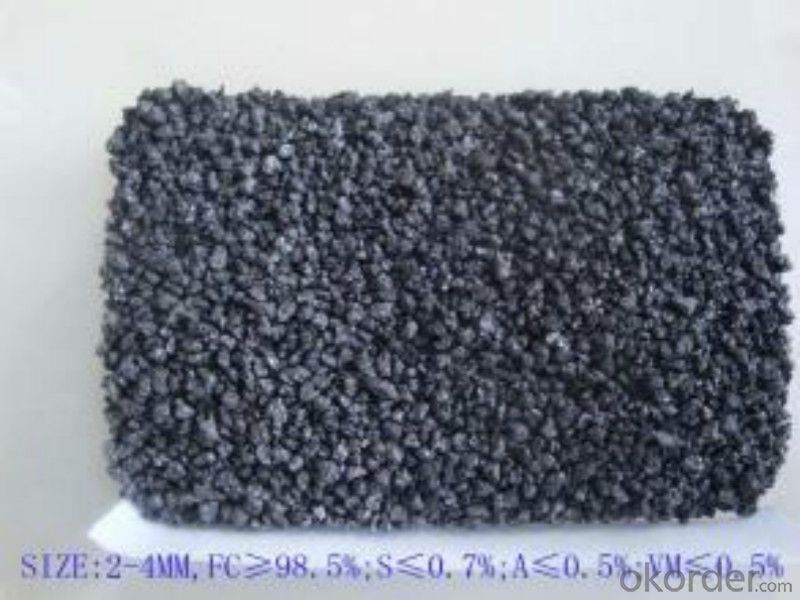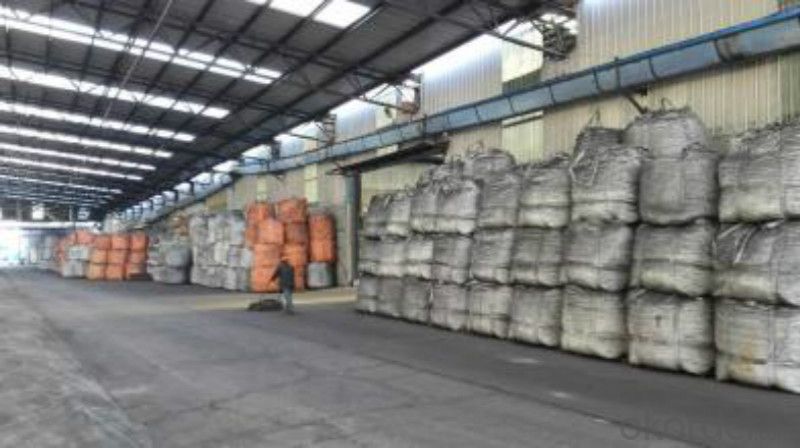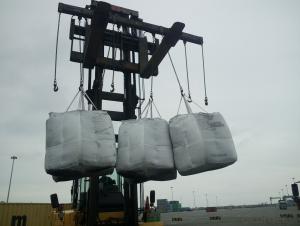Calcined Pitch Coke with VM 0.5 percent max for Steel-making
- Loading Port:
- Tianjin
- Payment Terms:
- TT OR LC
- Min Order Qty:
- 21 m.t.
- Supply Capability:
- 8000 m.t./month
OKorder Service Pledge
OKorder Financial Service
You Might Also Like
Introduction
Pitch Coke/Coal Tar Pitch is a kind of black brittleness and blocky piece, lustrously at normal temperature. It has special odour and poisonous and can be easily flame when melting, second-grade inflammable solid.
Pitch Coke/Coal Tar Pitch is obtained from powerfully processed coal tar. Compared to petroleum asphalt, the adhesiveness is better. Coal Tar Pitch is high quality tar production with high fixed carbon. It has excellent adhesion, waterproofing and resistance against seawater, oil and various chemicals. In these properties, it is much better than petroleum asphalt tar.
It can be used to produce painting, electrode, pitch coke, and tar felt. It also can be used as fuel and the raw material of asphalt carbon black.
Features:
The morphology, chemistry and crystallinity of recarburisers have a major impact on the overall casting cost. The combined application and cost benefits, which are derived through the use of Desulco, enable foundries to manufacture castings in a highly cost effective manner.
reduces
Recarburiser consumption
Power consumption
Inoculant consumption
MgFeSi consumption
Furnace refractory wear
Scrap rate
Tap to tap time
Slag inclusions risk
Chill
increases
Casting microstructure
Productivity
Process consistency
Carbon Recovery
Compared with calcined petroleum coke, acetylene coke and
graphite electrode scrap, Desulco yields the highest carbon
recovery and fastest dissolution time
Specifications:
CPC | |||
F.C.% | 98.5MIN | 98.5MIN | 98MIN |
ASH % | 0.8MAX | 0.8MAX | 1MAX |
V.M.% | 0.7 MAX | 0.7 MAX | 1 MAX |
SULFUR % | 0. 5MAX | 0. 7MAX | 1MAX |
MOISTURE % | 0.5MAX | 0.5MAX | 1MAX |
Pictures:




FAQ:
1.MOQ:2 Containers |
2.Size:1-3mm,1-5mm,2-6mm,3-5mm and as the customer's requirement |
3.Packing: 1 ton jumbo bag or 25kgs paper in bag |
4.Payment:T/T or L/C at sight |
5.Delivery time: within 15 days after receiving the deposit |
6.Usage: it is as carbon raiser,widely used in steelmaking,casting,casting iron,steel foundry,aluminum metallury. |
- Q:How does carbon contribute to the flavor of food?
- There are multiple ways in which carbon, found in charcoal or charred substances, can enhance the flavor of food. Firstly, when food is cooked over charcoal, the carbon gives it a smoky taste and aroma, which enhances the overall flavor. This smokiness is particularly desirable in dishes such as barbecued meats, vegetables, and certain cheeses, as it adds a unique and enjoyable element to the taste. Additionally, carbon can serve as a natural filter, absorbing and eliminating impurities from food and drinks. This filtration process helps to get rid of unpleasant smells and flavors, resulting in a cleaner and more refined taste. For instance, activated carbon is often used in the production of alcoholic beverages like whiskey or vodka to remove impurities and create a smoother and more flavorful drink. Moreover, carbon can contribute to the development of desirable texture and color in certain foods. When sugar or other carbohydrates are heated, they undergo caramelization, a process in which the sugars react with heat to form a complex mixture of carbon compounds. This caramelization process creates rich, golden-brown hues and a unique depth of flavor, enhancing the overall taste experience. Lastly, carbon plays a crucial role in the fermentation process, which is essential in producing various types of food and drinks. During fermentation, microorganisms consume sugars and release carbon dioxide, which contributes to the texture, flavor, and carbonation of the final product. This is particularly evident in bread, beer, wine, and other fermented foods, where the presence of carbon dioxide adds lightness, complexity, and effervescence to the flavor. To summarize, carbon enhances the flavor of food through its ability to impart smokiness, act as a natural filter, facilitate caramelization, and participate in fermentation processes. Its presence in different forms enhances the taste, texture, and overall enjoyment of a wide range of food and drinks.
- Q:How does carbon affect the migration patterns of animals?
- Carbon emissions and the subsequent increase in greenhouse gases have been found to have a significant impact on the migration patterns of animals. One of the key ways carbon affects migration is through climate change. As carbon dioxide levels rise, the Earth's temperature also increases, leading to alterations in weather patterns and the timing of seasons. These changes can disrupt the natural cues and signals that animals rely on to initiate migration. For some species, migration is triggered by changes in temperature, daylight hours, or the availability of food sources. However, with climate change, these cues may become inconsistent or altered, leading to confusion and disruption in migration patterns. For example, migratory birds rely on the availability of insects and other food sources during their journey, but changing temperatures and shifts in plant and insect life cycles can affect the timing and availability of these resources, potentially leading to food shortages and impacting their ability to complete their migrations successfully. Additionally, carbon emissions have led to changes in habitat and ecosystems that further influence migration patterns. Rising temperatures and changes in precipitation patterns can alter the distribution and abundance of plant species, which can, in turn, affect the availability of food and shelter for migratory animals. Some species may find their traditional breeding or feeding grounds no longer suitable due to these changes, forcing them to alter their migration routes or patterns. Furthermore, carbon emissions also contribute to the melting of polar ice caps and the subsequent rise in sea levels. This has a direct impact on marine species that rely on specific breeding grounds or feeding areas. As their habitats shrink or disappear, these animals may be forced to migrate to new areas or face extinction. Overall, the increase in carbon emissions and resulting climate change have profound effects on the migration patterns of animals. Disruptions in weather patterns, altered cues for migration, changes in habitat, and shifts in food availability all contribute to the challenges faced by migratory species. Understanding and mitigating the impact of carbon on migration is crucial to ensure the survival and well-being of these animals in a rapidly changing world.
- Q:What is carbon fiber and how is it used?
- Carbon fiber is a lightweight and strong material composed of thin strands of carbon atoms. It is used in various industries, including aerospace, automotive, and sports equipment manufacturing. It is commonly used to make components that require high strength and low weight, such as aircraft wings, car bodies, bicycle frames, and tennis rackets. Its excellent mechanical properties, including high tensile strength and stiffness, make it an ideal choice for applications where strength and weight reduction are crucial.
- Q:What is carbon neutral packaging?
- Packaging that is carbon neutral is characterized by having no carbon footprint. This implies that the emissions of carbon dioxide (CO2) released during the production, transportation, and disposal of the packaging are counterbalanced by an equal amount of CO2 being removed from the atmosphere or not emitted in the first place. To achieve carbon neutrality, a range of strategies can be implemented. One commonly used method is to utilize renewable or recycled materials for packaging, such as paper or bioplastics derived from plant-based sources. These materials have a lower carbon footprint compared to traditional petroleum-based plastics. Furthermore, reducing the quantity of packaging used overall and optimizing its design to minimize waste can also contribute to carbon neutrality. Offsetting unavoidable emissions is another crucial aspect of carbon neutral packaging. This can be accomplished by investing in projects that reduce greenhouse gas emissions elsewhere, such as reforestation or renewable energy initiatives. By supporting these projects, the carbon emissions produced by the packaging are counteracted, resulting in no overall impact on the environment. The concept of carbon neutral packaging is gaining traction as businesses and consumers become more cognizant of the environmental consequences of their choices. It offers a means to decrease the carbon footprint associated with packaging, ultimately contributing to a more sustainable and environmentally friendly future.
- Q:15CrMo seamless steel tube and carbon plate welding fracture what is the reason?
- Welding stress should be too concentrated, 15CrMo material is very brittle after quenching, when welding local high temperature, and then no corresponding insulation measures, lead to fracture.Welding: welding, can also be written as "welding" or welding, melt, is two or more than two kinds of material (homogeneous or heterogeneous) by heating and pressurizing, or both, so that the two parts produce atomic binding processing and connection mode. Welding is widely used, both for metals and for metals. Welding is the process of welding the workpiece interface to the molten state, without pressure to complete the welding process. When welding, the heat source rapidly melts and melts at the interface of the two workpiece to be welded to form a molten pool. The molten pool moves along with the heat source, and a continuous weld seam is formed after cooling, and the two workpieces are connected into a whole.
- Q:Which carbon content is larger, steel or pig iron?
- carbon content more than 2.11% of iron, iron carbon content in general industry 2.5%--4%. I hope I can help you.
- Q:What is the relationship between carbon emissions and air pollution?
- Carbon emissions and air pollution are closely interconnected. Carbon emissions, which mainly come from burning fossil fuels such as coal, oil, and natural gas, release large amounts of carbon dioxide (CO2) into the atmosphere. This increase in CO2 levels contributes significantly to the greenhouse effect, trapping heat in the atmosphere and leading to global warming. Air pollution, on the other hand, refers to the presence of harmful substances in the air that can be detrimental to human health and the environment. While carbon dioxide itself is not directly toxic to humans, it plays a crucial role in the formation of other air pollutants. One of the primary consequences of increased carbon emissions is the production of fine particulate matter (PM2.5) and ground-level ozone (O3). These pollutants are created through complex chemical reactions involving CO2 and other pollutants like nitrogen oxides (NOx) and volatile organic compounds (VOCs). PM2.5 and O3 are known to cause respiratory problems, cardiovascular diseases, and other health issues. Furthermore, carbon emissions also contribute to the formation of other air pollutants such as sulfur dioxide (SO2), nitrogen oxides (NOx), and heavy metals. These pollutants are emitted alongside CO2 from various industrial processes, power generation, and transportation. They can have severe health impacts, including respiratory diseases, asthma, and even cancer. Reducing carbon emissions is crucial to combatting air pollution. By transitioning to cleaner energy sources like renewables and improving energy efficiency, we can significantly reduce the amount of CO2 and other pollutants emitted into the atmosphere. Implementing stricter regulations and adopting cleaner technologies in industries and transportation can also help reduce air pollution and its associated health risks. In conclusion, carbon emissions and air pollution are intrinsically linked. The release of CO2 and other pollutants from burning fossil fuels contributes to global warming and the formation of harmful air pollutants. Addressing the problem of carbon emissions is essential to mitigate air pollution and protect human health and the environment.
- Q:What are the impacts of carbon emissions on the stability of deserts?
- Carbon emissions have a significant impact on the stability of deserts. Increased levels of carbon dioxide in the atmosphere contribute to global warming, leading to higher temperatures and altered precipitation patterns. These changes can intensify desertification processes, such as soil erosion and water scarcity, further destabilizing desert ecosystems. Additionally, carbon emissions from human activities, such as fossil fuel combustion, contribute to air pollution, which can harm desert flora and fauna, disrupting their ecological balance and overall stability.
- Q:How does carbon dioxide affect the Earth's climate?
- The Earth's climate is significantly affected by carbon dioxide (CO2), a greenhouse gas. When released into the atmosphere through natural and human activities like deforestation, burning fossil fuels, and industrial processes, carbon dioxide traps heat from the sun and prevents it from escaping into space. This process is commonly referred to as the greenhouse effect. The accumulation of carbon dioxide in the atmosphere leads to a rise in global temperatures, resulting in climate change. As CO2 levels increase, more heat gets trapped, causing the Earth's average temperature to rise over time. This phenomenon is known as global warming. The consequences of increased carbon dioxide levels and subsequent climate change are extensive. Rising temperatures cause glaciers and polar ice caps to melt, contributing to a rise in sea levels. This can lead to coastal flooding, displacement of communities, and loss of biodiversity. Moreover, altered weather patterns, including more frequent and intense heatwaves, droughts, and extreme weather events like hurricanes and storms, are also associated with increased carbon dioxide levels. These events can have devastating impacts on ecosystems, agriculture, and human settlements. Furthermore, elevated CO2 levels also impact the chemistry of the oceans, making them more acidic through a process called ocean acidification. This poses a threat to marine life, especially organisms with calcium carbonate shells, such as corals and shellfish. To mitigate the impacts of carbon dioxide on the Earth's climate, it is crucial to reduce greenhouse gas emissions. This can be accomplished by transitioning to renewable energy sources, improving energy efficiency, promoting sustainable land use practices, and adopting cleaner technologies. Additionally, initiatives like afforestation and reforestation can help absorb CO2 from the atmosphere, acting as carbon sinks. Taking action to address the issue of carbon dioxide and its impact on the Earth's climate is vital to protect the planet's ecosystems, biodiversity, and human societies. By reducing carbon emissions, we can lessen the effects of climate change and work towards a more sustainable future.
- Q:How does carbon affect the formation of landslides?
- The formation of landslides is not directly influenced by carbon. Instead, natural factors such as heavy rainfall, earthquakes, or volcanic activity, as well as human activities like deforestation or construction, primarily trigger landslides. However, carbon does have an indirect role in landslides through its impact on the environment. The emission of excessive carbon dioxide (CO2) is primarily caused by human activities like burning fossil fuels and deforestation, and this contributes to climate change. As a result of climate change, rainfall events become more frequent and intense, increasing the likelihood of landslides. The increased rainfall saturates the soil, making it heavier and more susceptible to sliding, particularly on steep slopes. Deforestation is another way in which carbon indirectly affects landslides. Trees play a crucial role in stabilizing slopes by anchoring the soil with their root systems. However, when forests are cleared for agriculture, urbanization, or logging, the loss of tree cover weakens the soil's stability and raises the risk of landslides. Furthermore, the absence of vegetation reduces rainfall absorption, leading to increased surface runoff and erosion, further destabilizing slopes and making them more prone to landslides. In conclusion, while carbon itself does not directly cause landslides, its impact on climate change and deforestation can indirectly contribute to the occurrence and severity of landslides. Addressing carbon emissions and promoting sustainable land management practices are essential to mitigate the risk of landslides and preserve the stability of slopes.
1. Manufacturer Overview |
|
|---|---|
| Location | |
| Year Established | |
| Annual Output Value | |
| Main Markets | |
| Company Certifications | |
2. Manufacturer Certificates |
|
|---|---|
| a) Certification Name | |
| Range | |
| Reference | |
| Validity Period | |
3. Manufacturer Capability |
|
|---|---|
| a)Trade Capacity | |
| Nearest Port | |
| Export Percentage | |
| No.of Employees in Trade Department | |
| Language Spoken: | |
| b)Factory Information | |
| Factory Size: | |
| No. of Production Lines | |
| Contract Manufacturing | |
| Product Price Range | |
Send your message to us
Calcined Pitch Coke with VM 0.5 percent max for Steel-making
- Loading Port:
- Tianjin
- Payment Terms:
- TT OR LC
- Min Order Qty:
- 21 m.t.
- Supply Capability:
- 8000 m.t./month
OKorder Service Pledge
OKorder Financial Service
Similar products
New products
Hot products





























